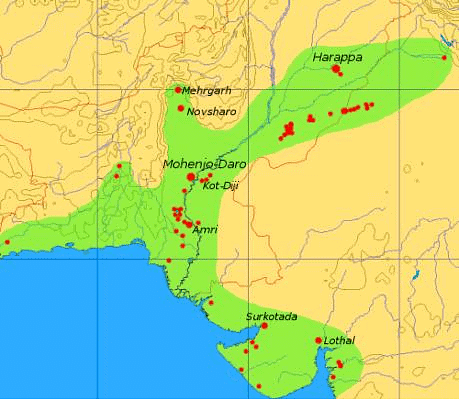Indus Valley Cities | History for UPSC CSE PDF Download
Indus Valley Civilisation
- The Indus Valley Civilisation unquestionably ranks as one of the greatest civilizations of the world.
- The civilization was essentially urban.
 Extent and major sites of the Indus Valley Civilisation
Extent and major sites of the Indus Valley Civilisation
Some Special Features Common to All Cities
Whether it is Harappa or Mohenjo-Daro, Kalibangan or Lothal, the most striking character is systematic town planning; the streets oriented north-south and east-west, produced a grid pattern.
Know the Important Facts
- Harappan seals were most probably used in connection with trade.
- Meluha was the ancient name given to the Indus region by the Mesopotamians.
- Mesopotamian cylindrical seals and cuneiform inscriptions have been found at Mohenjo-daro.
- Archaeological excavations at Indus Valley sites show that houses had wells in Kalibangan.
- Stone implements were largely used by the Indus people.
- The Harappans were the earliest people to produce cotton.
- Most Harappan inscriptions were recorded on seals.
- Flanking the streets and similarly oriented lanes and by-lanes were well-planned houses.
- The buildings, considerably varying in size, appear to have been plain but dignified. Stone not being easily obtainable, walls were raised of burnt brick, laid in mud or in both mud and gypsum mortar.
- Crude or sun-dried bricks were reserved for foundations and terraces, where the elements could not do much damage. Both rooms and circular brick walls were important features of most houses.
- The system of drainage, public or private was remarkable. Each city had a fortified citadel possibly used for both religious and governmental purposes.
- Dust bins and rubbish chutes indicate the extreme care taken in matters of conservancy.
- The commodious houses, knit into a system of rigid town-planning, the public-buildings, large granaries and the citadel, all combine to present the picture of prosperous people, controlled by a firm yet beneficent authority.
Mohenjo-daro
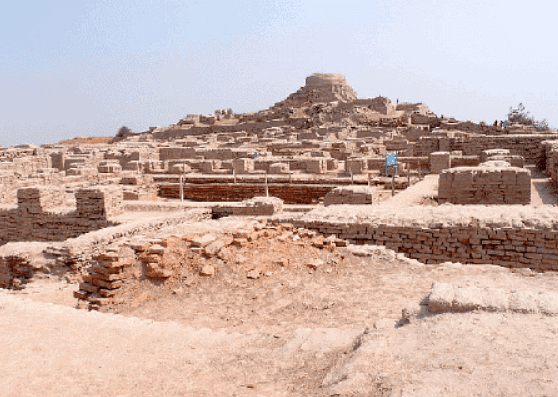 Traces of Mohenjo-daro Present Today
Traces of Mohenjo-daro Present Today
- The ‘city of the dead’, is at present a heap of ruins. The most dramatic characteristic of the city is a commanding citadel. It is a massive, mud-filled brick embankment that rises 43 feet above the lower city.
- There lay in the citadel a multi-pillared ‘Assembly Hall’ and the so called ‘Great Bath’.
- The pool, surrounded by a paved courtyard, is 39 feet long, 23 feet wide and 8 feet deep.
- Most Mohenjo-daro houses are built of kiln fired brick. The major streets are 33 feet wide and run north-south intersecting subordinate ones, running east-west, at right angles.
- Its drains with a corbelled roof, more than 6 ft in height, deserves particular mention.
- The evidence of Indian ships (figured on the seal) and a piece of woven cloth has been discovered from here.
- Also present are the remains of shops, and of structures so substantial as to suggest temples or religious buildings.
- There is a large granary consisting of a podium of square blocks of burnt-bricks with a wooden superstructure.
- Parallel rows of two-roomed cottages were found. These cottages were perhaps used by the workmen or poor section of the society.
- It is important to remember that Mohenjo-daro shows nine levels of occupation towering over 300 feet above the present flood plain.
- Excavation reveals that the city was flooded more than seven times.
- In 1922, R D Banerji, one of the Superintendent Archaeologists of the Archaeological Survey of India, decided to excavate the Buddhist stupa that dominated the site.
Major archaeological findings of Mohenjo Daro
- The great bath
- Citadel
- Bronze statue of dancing girl
- Bronze buffalo
- Steatite statue of a bearded priest
- Seal of Pashupati
- The great granary
- Assembly hall
- 3 cylindrical-shaped seals similar to Mesopotamian ones.
- Terracotta toys
- A piece of woven cloth
Harappa
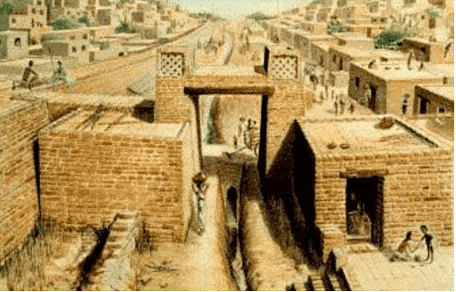 Gateway at Harappa
Gateway at Harappa
- It is situated on the river Ravi. The ruins of Mohenjo-Daro and Harappa suggest that capital cities existed here.
- The most remarkable and the largest building at Harappa is the Great Granary measuring 169 ft x 35 ft.
- The citadel at Harappa also displays a Great Bath but of a slightly different design.
- Between the granary and the citadel, have also been found a series of circular platforms, probably for the pounding of grain.
- At a lower level below the granary platforms and the citadel, were crowded single-celled dwellings which have suggested slave habitats.
- Two sandstone statuettes found here in which human anatomy is depicted. The Cemetery H culture is also found here.
- The Harappa site was first briefly excavated by Sir Alexander Cunningham in 1872-73, two decades after brick robbers carried off the visible remains of the city. He found an Indus seal of unknown origin.
Major archaeological findings which have been unearthed from Harappa
- Two sandstone statues depicting human anatomy
- Ekkas (Bullock carts)
- Two rows of six Granaries
- workmen quarters
- Bronze sculpture of a dog chasing a deer
- Red sandstone male torso
- Sculpture of mother goddess
- Pottery with an Indus script on it.
- Faience slag
- Terracotta figurines
Kalibangan
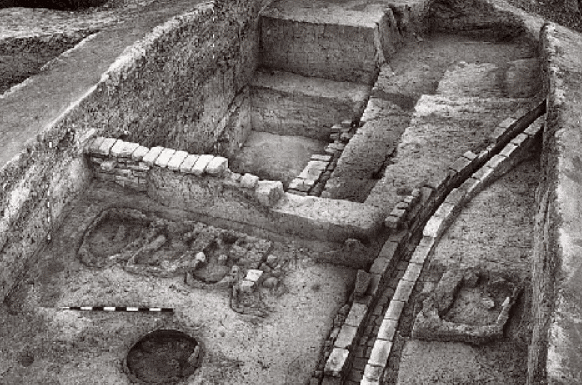 Drainage System in Kalibangan
Drainage System in Kalibangan
- Kalibangan is situated on the ancient Sarasvati, now called Ghaggar in Rajasthan.
- Since the Harappan city overlies the earlier proto-Harappan, clear house plans of the earlier city are not available.
- But in some houses, we have evidence of ovens and a well-aligned lane.
- There is also evidence of mud-brick fortification. The Pre-Harappan phase here shows that the fields were ploughed, unlike the Harappan period.
- One of the platforms within the citadel had fire altars that contained ash.
- Another platform has a kiln-burnt brick-lined pit containing bones. These suggest the practice of the cult of sacrifice.
- The existence of wheel conveyance is proved by a cartwheel having a single hub.
- The Kalibangan pre-historic site was discovered by Luigi Pio Tessitori, an Italian Indologist (1887–1919).He was doing some research in ancient Indian texts and was surprised by the character of ruins in that area. He sought help from Sir John Marshall of the Archaeological Survey of India.
Things that were unearthed from Kalibangan city
- Double citadel
- Burnt bangles
- Fire altars
- Sun-dried bricks
- Ploughed fields
- Wooden plough
- Bones of camel
- Lower fortified town
- Earthquake evidence
- Copper ox
- Small circular pits with large urns and pottery
Lothal
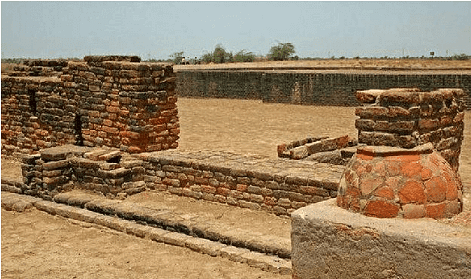 Ancient Port, Lothal
Ancient Port, Lothal
- This is situated on the bank of Bhogavar.
- Only at Lothal and Rangpur, Rice husk has been found.
- Archaeologist S.R. Rao led teams who discovered a number of Harappan sites, including the port city of Lothal in 1954-63.
- The use of weights and measures proves that they knew arithmetic as well which is shown by a scale found at Lothal. It was surrounded by a thick, mud-brick wall on three sides, southern, western and northern.
- On the eastern side is located a dockyard and wharf loading platform.
- A doubtful terracotta figurine of a horse is found here.
Archaeological findings from Lothal
- Port and dockyard
- Single citadel
- An exclusive feature of lothal is that it has a house with an entrance facing the street
- Couple burial
- The seal with the story of a clever fox
- Mesopotamian seal made of ivory
- Rice husk
- Chess game
- Terracotta figures of horse and ship
Kot Diji
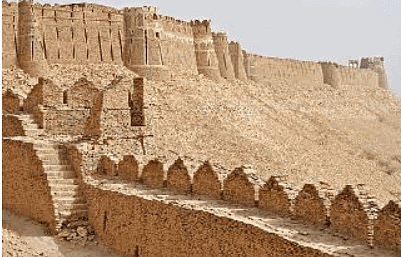 Kot Diji Fort
Kot Diji Fort
- It is situated on the left bank of Indus river about 50 km east of Mohenjo-daro.
- R Rao excavated the site in 1957 - 58.
- Wheel made of painted pottery, traces of a defensive wall and well-aligned streets, knowledge of metallurgy, artistic toys etc.
- Five figurines of the Mother Goddess were also discovered.
Sutkagendor
 Sutkagendor
Sutkagendor
- In 1929, Sutkagendor, a significant site of the Indus Valley Civilization, was excavated by the archaeologist Stein.
- Located in the Makran district of Balochistan (Pakistan), along the banks of the Dast river, Sutkagendor stands as the westernmost known site of the civilization.
- The site includes a citadel and a 30-foot-wide defensive wall, typical of Harappan sites. It is believed to have been part of the trade route from Lothal to Mesopotamia.
Archaeological Findings
- Stone vessels
- Pottery
- Shell beads
- Bangles made out of clay
Chanhudaro
 Chanhudaro
Chanhudaro
- Chanhudaro, a Harappan site, was excavated in 1931 by N.G. Majumdar and his team in the Nawabshah district of Sindh, Pakistan, along the Indus River. Situated 80 miles south of Mohenjo Daro.
- The city served as a manufacturing hub of the Indus Valley Civilization and likely became abandoned. It is often referred to as the Lancashire of ancient India and notably lacks a citadel.
Archaeological Discoveries
- Traces of a bead maker's factory
- Early use of kajal and lipstick
- Discovery of an inkpot
- Impression of a cart with a seated driver
Surkotada
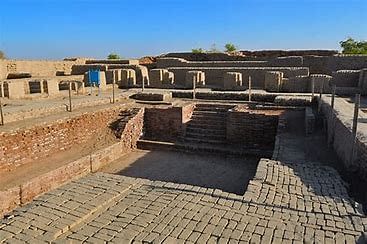 Surkotada
Surkotada
- J.P. Joshi conducted excavations at the Surkotada site of the Indus Valley Civilization in 1964.
- Surkotada is situated in the Kutch district of Gujarat, along the banks of the Shadi Kaur river.
- The Harappans established a settlement at Surkotada during the later phase of the civilization, approximately between 1900 BC to 1300 BC.
- Surkotada stands out as the sole Harappan site where tangible evidence of horse bones was unearthed.
- Surkotada is a fortified Harappan site covering an area of about 3.5 acres. Residential complexes were built on the East, while the Citadel was positioned on the West. Notably, Citadels were situated at higher elevations compared to residential areas.
Archaeological Discoveries
Key findings at Surkotada include remains of horse, elephant, and wolf bones, as well as stone fortifications.
Banawali
 Banawali
Banawali
- Banawali stands as a significant archaeological site from the Indus Valley Civilization, discovered by R.S. Bisht in 1974. Situated in the Fatehabad district of Haryana, it lies approximately 120km northeast of Kalibangan.
- The city comprises a well-structured fort town encompassed by a defensive wall standing at a height of 4.5m. Houses were constructed using burnt and molded brick kilns.
Archaeological Discoveries
- Barley grains of superior quality
- Toy plough
- Oval-shaped settlement
- Burnished grayware adorned with motifs
- Ivory comb
- Tortoiseshell
- Human figures depicting both males and females
- S-shaped jars, painted earthen pots, cooking vessels, etc.
Amri
 Amri
Amri
- It is situated south of Mohenjo-daro.
- In Pakistan, Jean-Marie Casal has directed the excavations at Amri (Sindh) in 1959-1962.
- Knowledge of metal working, use of wheel pottery with animal figures painted on it, construction of rectangular houses, etc.
Balakot
- Situated near the middle of the Khurkera plain on the south-eastern side of the Las Bela Valley and Somani Bay about 98 km north-west of Karachi.
- Robert Raikes, discovered the small site of Balakot, some 55 miles north of Karachi, on the east side of Sonmiani Bay in 1959-1960.
- There is a wide east-west lane almost bisecting the area at right angles with two smaller lanes.
- Mud bricks were the standard building material although a few drains were lined with kiln-burnt bricks also.
- There is some evidence for the thin plastering of floors but it was not done as the usual practice.
Desalpur
 Desalpur
Desalpur
- Situated near Gunthali in Nakhatrana taluka of Bhuj district (Gujarat) on the Bhadar river.
- Discovered by P. P Pandya and MA Dhakey in 1963.
- It was a fortified township built of dressed stone with mud filling inside.
- The houses were constructed just against the fortification wall. In the centre, was found a building having massive walls.
Ropar
 Ropar
Ropar
- Situated near the confluence of Sutlej, some 25 km east of Bara.
- Discovered by Y. D. Sharma in 1953.
- The excavations have yielded a five-fold sequence of cultures—Harappan, PGW, NBP, Kushana-Gupta and Medieval.
- Discovery of pottery related to the Kalibangan-I.
- The evidence of burying a dog below the human burial is very interesting.
- One example of a rectangular mud-brick chamber was noticed.
Dholavira
 Dholavira
Dholavira
- It is a modest village in the Bhachau taluka of district Kutch in Gujarat.
- It is the latest and one of the two largest Harappan settlement in India, the other being Rakhigarhi in Haryana.
- The mounds of Dholavira was first explored by Dr. J.P. Joshi in 1966.
- The other Harappan towns were divided into two parts—‘Citadel’ and ‘the Lower Town’, but Dholavira was divided into three principal divisions, two of which were strongly protected by rectangular fortification. No other site has such an elaborate structure.
- In 1990-91 a team of archaeologists led by Dr R.S. Bisht of the ASI conducted extensive excavations.
Additional Information
Indus Valley Civilization Sites | Location |
Amri | Located in the Dadu district of Sindh, Pakistan |
Alamgirpur | Located in the Meerut district of Uttar Pradesh, India. |
Balu | Located in the Kaithal district of Haryana, India |
Balathal | Located in the Udaipur district of Rajasthan, India |
Daimabad | Located in the Ahmednagar district of Maharashtra, India. |
Desalpur | Located in the Kutch district of Gujarat, India |
Ganeriwala | Located in West Punjab, Pakistan |
Karanpura | Located in the Hanumangarh district of Rajasthan, India |
Kunal | Located in the Fatehabad district of Haryana, India |
Kot Diji | Located in the Khairpur district of Sindh, Pakistan |
Kot Bala | Located in the Lasbela district of Balochistan, Pakistan. |
Mehrgarh | Located in the Kachi district of Balochistan, Pakistan |
Mandi | Located in the Muzaffarnagar district of Uttar Pradesh, India |
Pabumath | Located in the Kutch District of Gujarat, India. |
Rangpur | Located in the Ahmedabad district of Gujarat, India |
Ropar | Located in the Rupnagar district of Punjab, India |
Sanauli | Located in the Baghpat district of Uttar Pradesh, India |
Shikarpur | Located in the Kutch district of Gujarat, India |
|
121 videos|490 docs|176 tests
|
FAQs on Indus Valley Cities - History for UPSC CSE
| 1. What are some special features common to all cities of the Indus Valley Civilisation? |  |
| 2. What are the important facts about Mohenjo-daro, Harappa, Chanhudaro, Banwali, Surkotada, Lothal, Kot Diji, Amri, and Balakot in the context of the Indus Valley Civilisation? |  |
| 3. What are the unique features of the city of Lothal in the Indus Valley Civilisation? |  |
| 4. How does Kot Diji differ from other cities of the Indus Valley Civilisation? |  |
| 5. What significance do the cities of Amri and Balakot hold in the study of the Indus Valley Civilisation? |  |

|
Explore Courses for UPSC exam
|

|
